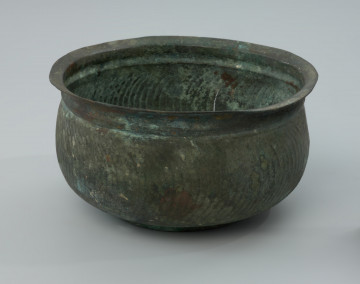
Decorated saucepan
National Museum in Szczecin
Part of the collection: Antiquity
The bronze bowl on a ribbed stand has two omega-shaped handles, thickened in the middle and ended with snakes’ heads, and is decorated with a slightly protruding roll around the body. This vessel was part of a barrow discovered in the cemetery of “princely graves” in Lubieszewo, Gryfice poviat, which is also known as Lubieszewo “Sandberg” - from the old German name for this town. Apart from the bowl, the burial also contained bronze drinking horn fittings, belt fittings, fibulae, a bronze mirror, a pottery vessel, another bronze vessel, and some unspecified bronze fittings. The burial chamber of the barrow was lined with worked stones, and the burial itself was covered with a stone structure. The barrow with a bowl was discovered in 1910 in the field of a farmer named Abraham, while the whole complex of barrows in Lubieszewo was discovered by accident at the beginning of the 20th century while extracting stones. Between 1908 and 1913, an amateur excavation of three barrows was conducted by Mr Vetter. In 1925, two more barrows were found at the site called Lubieszewo “Tunnenhult”, also with stone structures inside the burial chambers. The barrows from Lubieszewo are of great importance for the study of the Roman period in Europe. Even the term “Lubieszewo-type” graves has been introduced into the literature. It refers to a category of exceptionally richly furnished burials of Germanic aristocracy, found throughout the entire Barbaricum. The graves in Lubieszewo were first described by Adolf Stubenrauch, followed by Otto Kunkel, director of the museum in Szczecin. Excavations were carried out in 1938-1939 by Hans Jürgen Eggers, and in 1964-1969 by Ryszard Wołągiewicz, an archaeologist from the Museum in Szczecin. The most recent fieldwork took place in 2006-2008 under the direction of Jan Schuster, an archaeologist from Berlin and Łódź. The vessel should be dated to the earlier Roman period (1st century), and the tomb should be associated with the settlement of the Gustow group.
Bartłomiej Rogalski
Author / creator
Dimensions
cały obiekt: height: 17.5 cm, diameter: 37.5 cm
Object type
furnishings and equipment; container; vessel (container); bowl
Technique
casting
Material
bronze
Creation / finding place
Owner
Muzeum Narodowe w Szczecinie
Identification number
Location / status

National Museum in Szczecin

National Museum in Szczecin

around 150 — 375
National Museum in Szczecin
DISCOVER this TOPIC
Museum of King Jan III's Palace at Wilanów
DISCOVER this PATH
Educational path